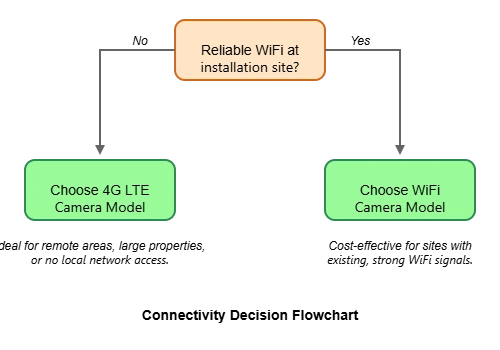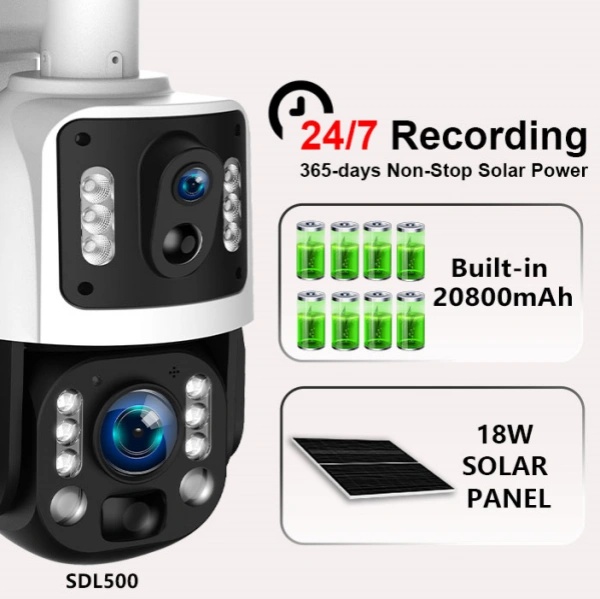Rental Property Security: The Wire-Free Advantage of Solar Cameras
For property managers, landlords, and real estate investors, security is a double-edged sword. While essential for protecting assets and ensuring tenant safety, traditional security systems present significant logistical and financial hurdles. The process of drilling holes, running wires, and managing complex installations is often impractical, costly, and disruptive, especially in a market defined by tenant turnover and varying property layouts.
The core challenge is finding a solution that is both effective and flexible. Landlords need to deter vandalism, prevent package theft, and monitor common areas without undertaking expensive, permanent modifications to their properties. This is a critical pain point that legacy wired systems, with their high upfront costs and structural invasiveness, simply cannot solve. The need for a rapidly deployable, non-invasive, and cost-effective security solution is more pressing than ever.
Why Traditional Security Systems Fail the Rental Market
The fundamental model of a wired security system is at odds with the dynamic nature of rental properties. Each new installation requires professional electricians, extensive cabling that can damage walls and ceilings, and a fixed infrastructure that is difficult to move or adapt. When a tenant leaves, the system either stays behind—a sunk cost—or requires costly removal and repair work.
This inflexibility creates a significant barrier for property owners. For B2B clients like security installers and distributors, offering a product that requires such high-touch installation limits your market and slows down project turnaround. Your customers need a better alternative. Here’s a direct comparison of why modern solar-powered cameras are engineered to outperform traditional systems in the rental sector.
| Feature | Traditional Wired Systems | Wire-Free Solar Security Cameras |
|---|---|---|
| Installation Cost | High (Requires professional electricians, cabling, and potentially trenching) | Low (DIY-friendly or minimal professional labor; no electrical work) |
| Deployment Speed | Slow (Days to weeks, depending on complexity) | Rapid (Minutes to hours per camera) |
| Portability | None (Fixed and permanent infrastructure) | High (Easily moved between properties or repositioned as needs change) |
| Property Damage | High (Drilling, wall damage, structural modifications) | Zero to Minimal (No-drill mounts or simple screw-in options) |
| Power Dependency | Reliant on grid power; vulnerable to outages without a UPS | Self-sufficient (Operates off-grid; immune to power outages) |
| Scalability | Difficult and expensive to add new cameras | Simple; add new cameras as needed without infrastructure changes |
The Engineering Behind Rapid Deployment: How Solar Cameras Work
From an engineering perspective, a wire-free solar security camera is a masterclass in efficiency and integration. It’s not just a camera with a solar panel attached; it’s a complete, self-sustaining ecosystem designed for autonomy and reliability. As a manufacturer, UBOXCAM focuses on optimizing the interplay between four critical components to deliver true “install-and-forget” performance.
The system begins with a high-efficiency monocrystalline solar panel, engineered to generate maximum power even in suboptimal light conditions. This energy is fed into a high-capacity lithium-ion battery pack, which is protected and managed by a sophisticated Battery Management System (BMS). The BMS is the unsung hero, preventing overcharging, over-discharging, and thermal runaway, thereby extending the battery’s lifespan to over five years. Learn more about how a BMS is the key technology for protecting your investment.
All operations are controlled by a low-power System on a Chip (SoC) that remains in a deep sleep state, consuming micro-amps of power. It only wakes when the PIR sensor detects motion or when a user initiates a live view. Finally, connectivity is handled by either a stable WiFi module or, more flexibly, an integrated 4G LTE module. This allows the camera to function anywhere with a cellular signal, completely independent of local network infrastructure.
Key Advantages for Rental Property Stakeholders
Translating this technology into business value is where the opportunity lies for our B2B partners. When you offer solar security cameras to the rental market, you are not just selling a product; you are solving their biggest operational headaches.
- For Property Managers & Landlords: The primary benefit is the reduction in Total Cost of Ownership (TCO). Zero wiring costs, no increase in electricity bills, and the ability to relocate a camera from a vacant unit to a new construction project means one asset can serve multiple purposes over its lifespan.
- For Installers & Dealers: Your business model is transformed. You can complete more jobs in a single day, reduce labor complexity, and offer solutions for previously inaccessible locations (e.g., detached garages, property perimeters, parking lots). This increases your revenue potential and market reach.
- For Brand Owners & Wholesalers: The demand for non-invasive security is a rapidly growing market segment. By partnering with a factory like UBOXCAM, you can source customizable, high-quality battery-powered security cameras that are tailored to the specific needs of property management, giving you a competitive edge.
Application Case Study: Solving Package Theft in a Multi-Unit Complex
Problem: A property management company overseeing a 50-unit apartment building was facing persistent issues with package theft from the mailroom and illegal dumping at their waste disposal area. Quotes for a traditional wired CCTV system exceeded $8,000 and required several days of disruptive installation work that would inconvenience tenants.
Solution: An installer partnered with UBOXCAM to propose a wire-free solution. Two 4G solar-powered PTZ cameras were deployed. One was mounted on a lamp post overlooking the main entrance and mailroom access, and the other was installed on the exterior wall near the dumpsters. Total installation time was under three hours, with no drilling into the main building facade and zero cabling.
Result: The impact was immediate and quantifiable. Within 30 days, reported package thefts dropped by over 90%. The high-visibility cameras acted as a powerful deterrent. Furthermore, clear footage from the second camera identified a non-resident illegally dumping commercial waste, leading to a municipal fine that covered the cost of one camera. Tenant satisfaction improved, and the property manager now plans to deploy similar solutions across their entire portfolio.
Overcoming Common Challenges: A Troubleshooting Guide for Installers
While solar cameras offer immense flexibility, successful deployment requires understanding a few key variables. As an engineer, I always advise our partners to plan ahead. Here are solutions to common field challenges:
- Insufficient Sunlight: Not every location has perfect sun exposure. If a camera must be placed in a shaded area (e.g., under an eave), use a model with a separated solar panel. This allows you to mount the camera in the optimal spot for surveillance and run a small, low-voltage cable to a nearby sunny location for the panel.
- Connectivity Issues: WiFi is great, but its range and reliability can be limiting in large properties or areas with thick concrete walls. This is where 4G models excel. A 4G security camera bypasses the local network entirely, providing a robust and independent connection. It’s the ultimate solution for parking lots, remote gates, or construction phases of a property.
- Tenant Privacy Concerns: This is a valid and important consideration. The best practice is to only install cameras in common areas like lobbies, hallways, parking areas, and exteriors. Never point cameras towards apartment doors or windows. Utilize privacy masking features in the camera software to block out sensitive areas and always inform tenants about the presence and purpose of security cameras.
Choosing the right technology is crucial for success. This simple decision-making process can help you and your clients select the best connectivity option.

Choosing the Right Solar Camera for Your Portfolio: A B2B Buyer’s Checklist
For distributors, wholesalers, and brand owners, selecting the right manufacturing partner and product line is critical. Not all solar cameras are created equal. Use this checklist to evaluate potential products and ensure they meet the professional standards your customers expect.
- ✅ Power System Integrity: Scrutinize the battery capacity (measured in Ah or mAh) and the solar panel’s true wattage (Wp). Most importantly, verify the quality of the Battery Management System (BMS). A superior BMS is the difference between a product that lasts one year and one that lasts five.
- ✅ Connectivity and Compatibility: For 4G models, ensure the camera supports the necessary LTE bands for your target regions (e.g., North America, Europe). For WiFi models, look for dual-band support (2.4/5 GHz) for greater flexibility.
- ✅ Build Quality and Durability: An IP66 rating or higher is non-negotiable for outdoor use. Check the operating temperature range to ensure reliability in harsh winters or hot summers. The housing should be UV-resistant ABS or metal.
- ✅ Imaging and Smart Features: Look beyond basic resolution. Does the camera offer Starlight or full-color night vision for superior low-light performance? Does it have advanced detection capabilities like PIR combined with AI-powered human/vehicle filtering to reduce false alarms?
- ✅ Supplier’s Customization Capability: Can the factory (like UBOXCAM) provide OEM/ODM services? This includes branding the device and app with your logo, modifying firmware, or even developing unique housing designs to differentiate your product in the market.
The Future of Rental Security: Scalability and Smart Integration
The market for rental property security is moving towards smarter, more integrated solutions. The future isn’t just about standalone cameras; it’s about creating a scalable security network. Solar-powered 4G cameras are the perfect foundation for this evolution. Because they are not tied to physical infrastructure, property portfolios can be secured with dozens or even hundreds of devices that all report to a single, centralized VMS (Video Management Software) platform.
We are already seeing a trend towards integration with property management software, allowing automated alerts and video verification for events like unauthorized access or maintenance requests. As AI analytics become more sophisticated, these cameras will do more than just record; they will provide actionable business intelligence, from tracking foot traffic in common areas to optimizing waste management schedules.
Partner with UBOXCAM for Your Rental Security Needs
The advantages of wire-free, solar-powered security cameras align perfectly with the needs of the modern rental market. They offer rapid deployment, zero-impact installation, and a cost-effective, portable design that traditional systems cannot match. For installers, distributors, and brands, this represents a significant and underserved market opportunity.
At UBOXCAM, we don’t just manufacture cameras; we engineer solutions. With over a decade of experience in design and production, we understand the nuances of power management, wireless connectivity, and durable construction. We offer robust customization options to help our B2B partners build their brands and deliver real value to their customers.
Ready to capitalize on the wire-free security revolution? Contact our engineering team today to discuss your project requirements, explore our extensive product line, and learn about our wholesale and OEM partnership programs.

